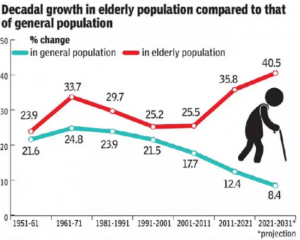[ad_1]
Introduction:
As India becomes increasingly urbanised and families break up into smaller units, homes for the elderly have sprung up.
The care of elderly people is managed by a set of professionals or voluntary organisations interested in geriatric services.
The number of such care homes is rising rapidly in urban and semi-urban India. These homes are either paid for, or offer free or subsidised service.
Typically, such homes are run by NGOs, religious or voluntary organisations with support from the government, or by local philanthropists.
They provide accommodation, timely care, and a sense of security for their residents.
However, the quality of service varies as these homes lack regulatory oversight.
Importance of Elderly population in any society:
- Elderly peoples carries immense experience of their personal and professional life, society at large need to channelise those experience for better tomorrow.
- They can provide a vital generational link for upcoming generations. It provides support and stability to families and society at large.
- Grandparents in joint families provide a crucial link for transferring values and morals to the younger generation in their initial years, thereby contributing towards upbringing of better human beings and responsible citizens.
- Their deep cultural impressions and social experiences provide the necessary buffer against intolerance, violence and hate crimes which provides stability in society especially in the era of hate and crime.
- They can play a significant role in easing out societal tensions, both within and outside families through their insight and understanding.
A rapidly growing section:
- A formal approach to homes for the elderly is an important policy and planning issue for India.
- The UN World Population Ageing Report notes that India’s ageing population (those aged 60 and above) is projected to increase to nearly 20% by 2050 from about 8% now.
- By 2050, the percentage of elderly people will increase by 326%, with those aged 80 years and above set to increase by 700%, making them the fastest-growing age group in India.
- With this future in mind, it is essential that our policy framework and social responses are geared to meet this reality.
- A recent set of research papers from Hyderabad focusing on the quality of health in homes for the elderly has some interesting insights.
- The papers highlight the fact that good intentions and a sense of charity are often inadequate when it comes to addressing the basic health needs of their elderly residents.
- Instead of planning for accessible and elderly-friendly structures that allow them to operate safely, we reduce their mobility.
- People with functional skills are asked to stay away from daily tasks like cooking, sewing, cleaning, or washing up.
- This reduces their sociability, their sense of independence and well-being — all leading up to mental health issues and depression.
- Our homes, buildings and social environment are not built keeping the elderly (or people with disabilities) in mind.
- As people age, and their motor skills weaken, they are at a greater risk of falling down and hurting themselves. Having an impairment increases this risk.
Legal backing for Elderly population:
- In 1982, the Report of the World Assembly on Ageing (also known as “the International Plan on Ageing”) was published, which represented the first international debate on the rights of older persons and presented a plan for their implementation.
- Convention on the Rights of Older Persons is proposed in united nation.
- The UNPF were tasked with implementing the Plan of the Second World Assembly which adopted “Madrid International Plan” on ageing in 2002.
- Article 41 and Article 46 are the constitutional provisions for elderly persons.
- Although directive principles are not enforceable under the law, but it creates a positive obligation towards the state while making any law.
- Section 20 of Hindu marriage and adoption act, 1956 makes it obligatory provisions to maintain an aged parents.
- Under Section 125 of Criminal Procedure Code, the elder parents can claim maintenance from their children.
- The Maintenance and Welfare of Parents and Senior Citizens Act, 2007, seeks to make it legal for the children or heirs to maintain their parents or senior citizens of the family.
Way Ahead suggestions: Public policy support:
- The state of homes for the elderly today offers us some low-hanging fruit we can address easily: build formal pathways for basic health screening between such homes and public health facilities.
- This can include screenings for blood sugar, blood pressure, periodic vision and hearing screening, and a simple questionnaire to assess mental health.
- Such interventions are inexpensive (think of all the motorcycle-operated screenings outside public grounds for morning-walkers) and could go a long way in identifying health issues and offering support.
- The next step would be to build formal pathways to address any health issues that such screenings identify. Many hospitals (public, NGO-run, and private care) can help.
- Crucial though will be the need for robust public policy to support homes for the elderly.
- Health institutions will also need to offer a comprehensive set of packages that are tailored for the elderly not piecemeal solutions for diabetes, cardiology or cancer, for example.
Conclusion:
Many homes lack clearly established standard operating procedures, and their referral paths to health care are informal.
There is an urgent need to understand the quality of life at such institutions, including the impact of these homes on the mental health of their residents.
Design, architecture and civic facilities must be thought from the ground up — and these innovations must be available for all residents, not just those living in expensive ones.
There are lessons here for society as a whole, but, as they say, let’s take one step at a time.
Homes for the elderly must be guided, again by policy, to make their facilities, buildings and social environment elderly- and disabled-friendly.
[ad_2]


